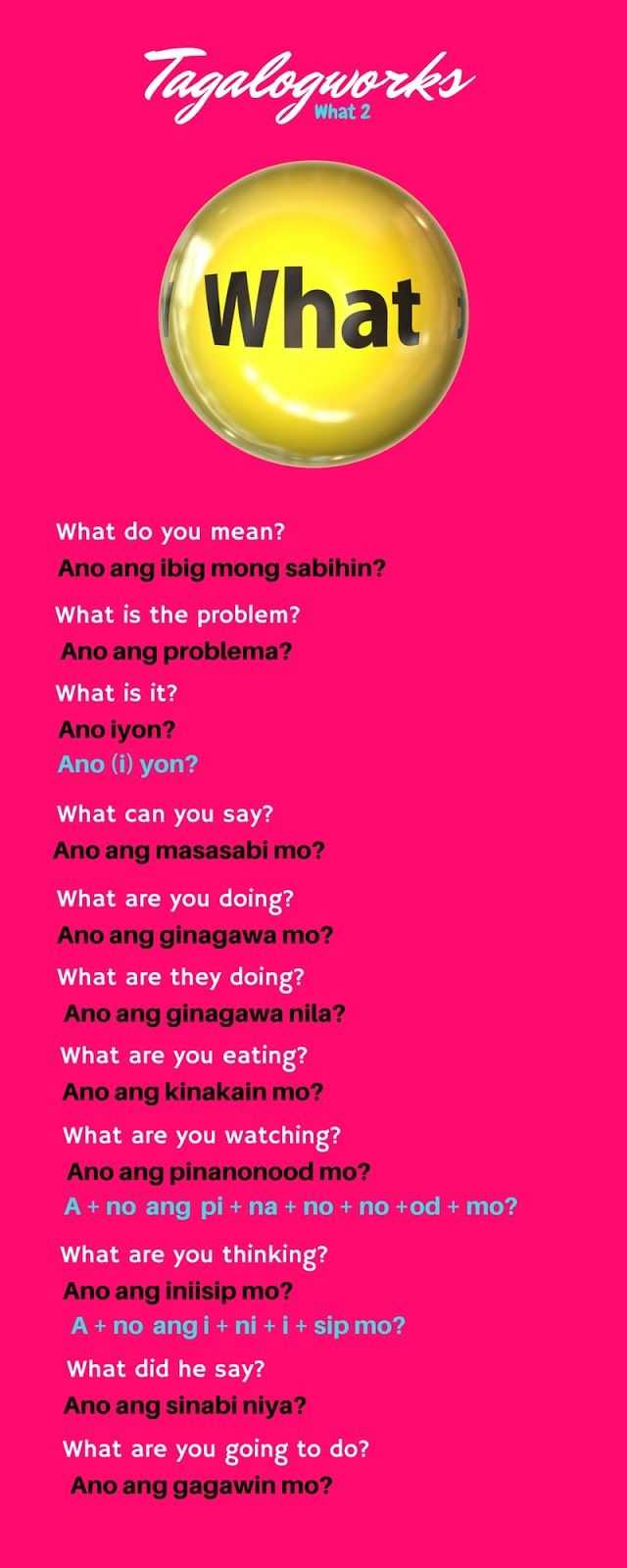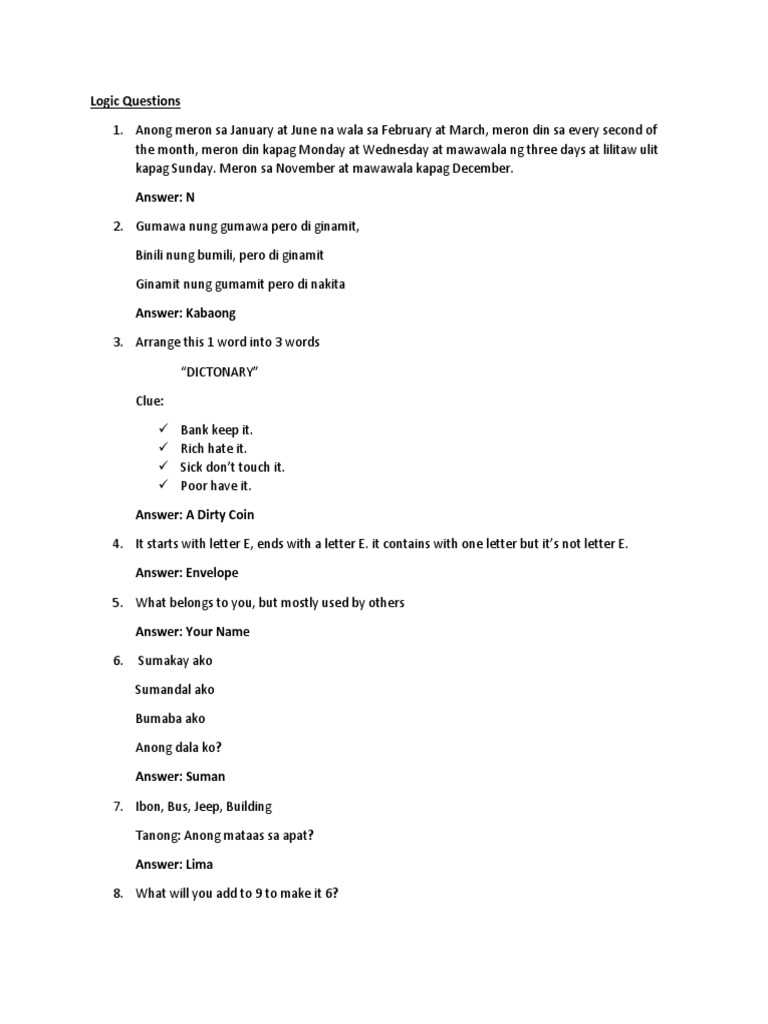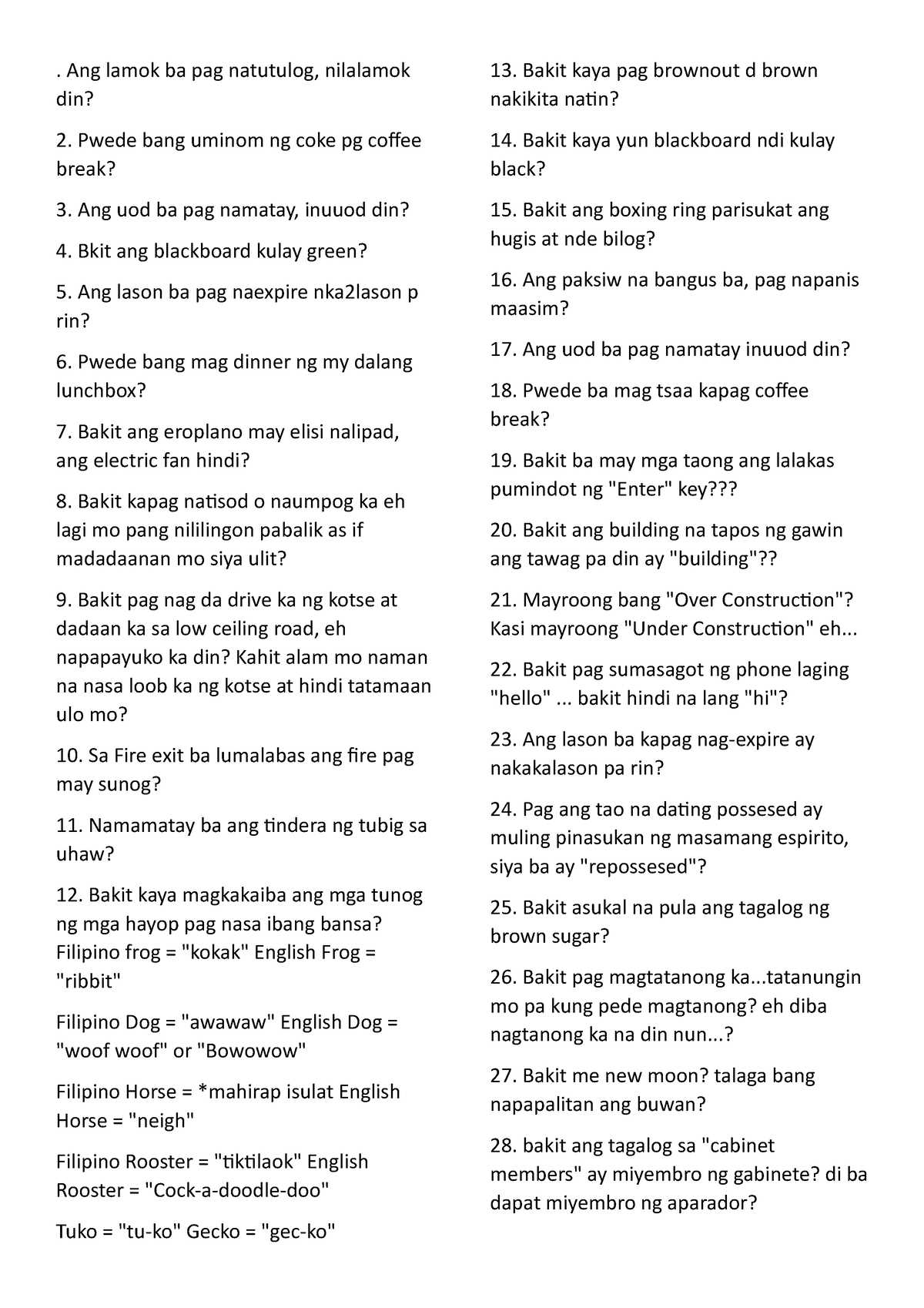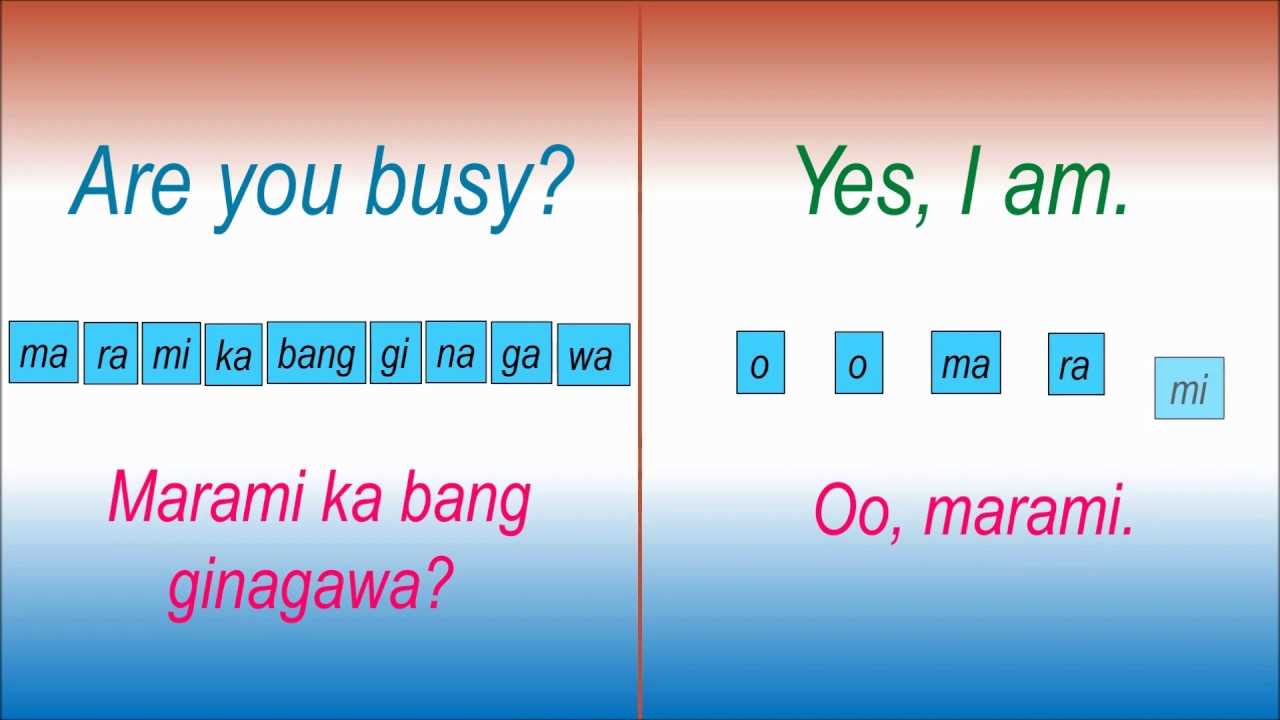
Learning how to communicate effectively in everyday situations is a key step when studying any language. In the Filipino language, it’s important to understand how to form basic inquiries and respond to them with clarity. Whether you are traveling, meeting new people, or simply engaging in casual conversations, knowing the right expressions will help you navigate through interactions with ease.
Filipino speakers often use specific structures to convey requests, gather information, or offer polite responses. These expressions are vital in building rapport and understanding, especially for those new to the language or those looking to refine their communication skills.
In this section, we’ll explore various ways to express curiosity, ask for assistance, and respond to common situations. Understanding these fundamental phrases will boost your confidence in daily exchanges and help you make meaningful connections with native speakers.
Basic Questions in Filipino Language
Understanding how to ask fundamental inquiries is essential when starting to learn Filipino. These expressions help you gather information or engage in daily exchanges effectively. By mastering these key structures, you’ll be able to navigate conversations with ease, whether you’re meeting new people, traveling, or seeking directions.
Below are some of the most common ways to ask for basic details or clarification in Filipino:
| Expression | Translation |
|---|---|
| Ano ito? | What is this? |
| Saan ka pupunta? | Where are you going? |
| Magkano ito? | How much is this? |
| Sigurado ka ba? | Are you sure? |
| Kailan ang party? | When is the party? |
| Nasaan ang banyo? | Where is the bathroom? |
These phrases serve as the foundation for most conversations, helping you engage with native speakers and understand their responses. Mastering them will provide you with the confidence to interact in various social settings.
Common Responses in Filipino Conversations
Being able to respond appropriately is just as important as asking questions in everyday communication. In Filipino, responses often reflect politeness, agreement, disagreement, or offer clarification. Understanding how to reply effectively will help you engage more naturally and respectfully in various situations.
Affirmative Responses
Here are some common ways to express agreement or confirm something in Filipino:
- Oo – Yes
- Opo – Yes (polite, formal)
- Tama – Correct
- Sige – Alright/Okay
- Walang anuman – You’re welcome (in response to “thank you”)
Negative Responses
When you need to decline or express disagreement, these are the phrases you can use:
- Hindi – No
- Wala – None/Not available
- Hindi ko alam – I don’t know
- Hindi pwede – Not possible
- Huwag – Don’t
Mastering these common replies will help you sound more fluent and confident during interactions. Whether agreeing, declining, or providing further information, knowing how to respond in Filipino will improve your conversational skills.
Useful Filipino Phrases for Beginners
For those just starting to learn the Filipino language, mastering a few essential expressions is key to communicating effectively. These basic phrases will help you handle common situations, ask for assistance, and engage in simple conversations with ease. Knowing these will provide a solid foundation for expanding your vocabulary and improving your skills.
Below are some useful expressions every beginner should know:
| Expression | Translation |
|---|---|
| Kamusta? | How are you? |
| Salamat | Thank you |
| Pasensya na | Sorry |
| Magandang araw | Good day |
| Puwede ba? | Is it possible? |
| Walang anuman | You’re welcome |
| Oo, pwede | Yes, it’s okay |
By practicing these fundamental expressions, beginners can quickly start interacting in Filipino, creating opportunities to learn and grow in the language.
How to Ask Directions in Filipino

When exploring a new place, knowing how to ask for directions is essential. In Filipino, there are simple and polite ways to inquire about the location of various places. Mastering these expressions will help you find your way around, whether you’re in a city, a small town, or even traveling to remote areas.
Asking for directions in Filipino typically involves using clear and straightforward phrases. People in the Philippines are usually friendly and helpful, so learning these basic expressions will ensure you get the information you need with ease.
Here are some common phrases to use when asking for directions:
| Expression | Translation |
|---|---|
| Saan ang pinakamalapit na estasyon ng bus? | Where is the nearest bus station? |
| Paano pumunta sa __________? | How do I get to __________? |
| Malayo ba ito? | Is it far? |
| Nasa kanan o kaliwa? | Is it on the right or left? |
| Puwede po bang magtanong? | Can I ask a question? |
These simple expressions will help you effectively navigate through any area. Whether you’re seeking directions to a specific landmark or just trying to find your way to the nearest shop, mastering these phrases will make your experience much smoother.
Polite Ways to Ask in Filipino
When engaging in conversations, being polite is essential, especially when making requests or inquiries. In Filipino, there are specific phrases and expressions used to show respect, especially when addressing elders or people you don’t know well. Using these courteous forms can help ensure your interactions are pleasant and well-received.
Polite Phrases for General Requests

Below are some common, polite ways to ask for something or request assistance in Filipino:
- Kung maaari po – If you don’t mind
- Puwede po bang – May I
- Pakisabi po – Please tell
- Pasensya na po – Excuse me/Apologies
- Maari ko po bang – May I
Polite Ways to Seek Information

When asking for help or information, it’s important to use respectful language. Here are polite ways to ask for directions or details:
- Posible po bang malaman – Is it possible to know
- Huwag po sanang magalit – Please don’t be upset
- Puwede po bang magtanong – May I ask
- Pakisabi po kung saan – Please tell me where
- Maari po bang tulungan ako – Can you help me
By incorporating these respectful phrases into your conversations, you will create a positive and courteous impression, making your interactions with native speakers more enjoyable and respectful.
Filipino Inquiries for Daily Conversations
In any language, being able to ask the right questions is crucial for meaningful exchanges. Whether you are shopping, meeting new people, or simply engaging in casual talk, knowing how to inquire about various topics can help you connect with others and get the information you need. In Filipino, there are numerous common phrases used in everyday situations that will enhance your ability to engage in fluid conversations.
Basic Questions for Social Interactions

When talking to friends, family, or strangers, the following expressions will help you ask about personal matters or daily activities:
- Kamusta ka? – How are you?
- Anong pangalan mo? – What is your name?
- Gusto mo ba ng kape? – Do you want coffee?
- Nasaan ka? – Where are you?
- Magkano ito? – How much is this?
Inquiries for Practical Information
These useful phrases can help you gather essential details about places, time, or plans:
- Kailan tayo aalis? – When are we leaving?
- Saan ang pinakamalapit na tindahan? – Where is the nearest store?
- May trabaho ba bukas? – Do you have work tomorrow?
- Puwede ba akong magtanong? – Can I ask something?
- Malayo ba ito? – Is it far?
Learning these common inquiries will improve your ability to navigate daily situations and interact more effectively with native speakers.
Understanding Filipino Yes and No Responses
In any language, knowing how to affirm or decline is essential for clear communication. In Filipino, the responses for “yes” and “no” are simple but can vary depending on the formality or context of the conversation. Understanding these nuances will help you respond appropriately in different situations, whether you’re agreeing, disagreeing, or politely declining a request.
Common Affirmative Responses
Here are the primary ways to say “yes” in Filipino, each used in different contexts:
- Oo – Yes (general use)
- Opo – Yes (polite/formal, often used with elders or in respectful situations)
- Sige – Okay/Go ahead (informal, commonly used among friends)
- Tama – Correct (used to affirm statements)
Common Negative Responses
To express disagreement or refusal, here are the common ways to say “no”:
- Hindi – No (general use)
- Wala – None/Not available (often used when something is absent or missing)
- Hindi pwede – Not possible (polite refusal)
- Huwag – Don’t (imperative, used to tell someone not to do something)
Mastering these basic affirmations and denials will help you engage more confidently in conversations and avoid misunderstandings.
Filipino Phrases for Traveling Abroad
Traveling to a foreign country can be a rewarding experience, but it often comes with challenges, especially when navigating through a new language. Learning a few basic expressions in Filipino can help ease your journey, whether you’re asking for directions, ordering food, or simply communicating with locals. These essential phrases will ensure you’re prepared for common travel situations, allowing you to enjoy your trip with more confidence.
Below are some useful expressions to know before traveling:
| Expression | Translation |
|---|---|
| Nasaan ang pinakamalapit na hotel? | Where is the nearest hotel? |
| Puwede bang magtanong? | Can I ask something? |
| Magkano ito? | How much is this? |
| May internet ba dito? | Is there internet here? |
| Puwede ba akong magbayad ng credit card? | Can I pay by credit card? |
| Saan ang pinakamalapit na ospital? | Where is the nearest hospital? |
| Maari ba akong tumulong? | Can I help? |
These phrases will come in handy for smooth communication while traveling, ensuring that you can easily navigate through foreign places and interact with locals in a friendly and respectful manner.
Asking for Help in Filipino

Whether you’re in an unfamiliar place or dealing with a challenging situation, knowing how to ask for assistance is an essential skill. In Filipino, there are several polite and common expressions you can use to request help. These phrases will allow you to ask for support, directions, or even clarification in a way that is respectful and effective, making it easier to navigate daily life.
Common Phrases for Requesting Assistance
If you’re in need of help, here are some basic expressions to use when reaching out to others:
- Maari po ba akong matulungan? – Can you help me?
- Puwede po ba? – Is it possible?
- May Ibigay po ba sa akin? – Could you give me?
- Pakitulungan po ako – Please help me
- Nasaan po ang – Where is the?
Polite Requests for Specific Support

For more specific needs, these phrases will help you ask for focused assistance:
- Puwede po bang magtanong? – Can I ask something?
- Maari po bang ipaliwanag? – Could you explain?
- Puwede po bang tawagan ang doktor? – Can you call the doctor?
- Puwede po bang makita ang menu? – Can I see the menu?
- May tulong po ba sa mga bata? – Is there assistance for children?
Using these polite expressions will help you approach others for support in a courteous way, fostering a positive interaction even in unfamiliar or stressful situations.
Questions for Ordering Food in Filipino
When dining out or ordering food, knowing how to inquire about the menu, make choices, and ask for specific items is important. In Filipino, there are several key expressions that will help you communicate your food preferences and needs effectively. Whether you’re at a restaurant or ordering takeout, these phrases will make your dining experience smoother and more enjoyable.
Below are some useful expressions to help you when ordering food:
- Anong mga pagkain ang meron? – What food do you have?
- Puwede bang makita ang menu? – Can I see the menu?
- May espesyal ba kayo ngayon? – Do you have any specials today?
- Gusto ko ng – I would like
- Puwede po bang walang – Can it be without?
- Anong inumin ang meron? – What drinks do you have?
- Magkano ito? – How much is this?
- Puwede bang pakibilisan? – Can you make it faster?
- May dessert po ba kayo? – Do you have desserts?
- Puwede bang magdagdag ng – Can I add?
With these expressions, you’ll be able to ask for exactly what you want and have a more seamless experience when ordering food in Filipino-speaking regions.
Filipino Expressions for Small Talk
Engaging in casual conversations is an important part of building relationships and connecting with others. Whether you’re meeting someone for the first time or chatting with a friend, knowing a few friendly expressions can make small talk more enjoyable. These common phrases will help you navigate informal conversations, express interest in others, and keep the conversation going smoothly.
Common Phrases for Casual Conversations
Here are some useful expressions that can help you start or continue a light-hearted conversation:
- Kumusta ka? – How are you?
- Anong balita? – What’s the news?
- Paano ang araw mo? – How’s your day?
- Kamusta ang pamilya mo? – How’s your family?
- Galing ka ba sa trabaho? – Are you coming from work?
- May plano ka ba mamaya? – Do you have plans later?
- Ang saya mo ngayon! – You look happy today!
Responding to Small Talk
Knowing how to respond politely is just as important as starting a conversation. These phrases will help you reply appropriately:
- Ayos lang, salamat! – I’m fine, thank you!
- Wala masyado, ikaw? – Not much, how about you?
- Medyo pagod ako, pero ok lang – I’m a bit tired, but I’m okay.
- Wala naman, nag-relax lang – Nothing much, just relaxing.
- Masaya ako, salamat sa tanong! – I’m happy, thanks for asking!
By using these friendly expressions, you’ll be able to maintain easy-going conversations and connect with others in everyday situations, making interactions more comfortable and enjoyable.
Inquiring About Time and Date in Filipino

Knowing how to ask for the time or date is essential in daily interactions. Whether you’re scheduling a meeting, planning an event, or simply checking the time, understanding the common phrases used in Filipino will help you navigate these situations with ease. These expressions will allow you to politely inquire about time or a specific date without confusion.
Here are some essential phrases for asking about the time and date:
- Anong oras na? – What time is it?
- Puwede po bang malaman kung anong oras? – Can I know what time it is?
- Ano ang petsa ngayon? – What’s the date today?
- Puwede ko bang malaman ang oras ng flight? – Can I know the flight time?
- Anong araw na bukas? – What day is tomorrow?
- Magkano na ang oras? – How much time has passed?
- Puwede po bang malaman kung kailan? – Can I know when?
By using these simple phrases, you’ll be able to ask for time or date-related information confidently, whether you’re in a formal or casual setting. These expressions are essential for effective communication, making it easier to plan your day and interact with others.
Filipino Phrases for Family and Friends
Engaging with loved ones often involves asking about their well-being, sharing experiences, or simply catching up. Whether it’s a casual chat with friends or a heart-to-heart conversation with family, knowing the right expressions will help you build stronger relationships. These simple but meaningful phrases are essential for maintaining connections with those who matter most to you.
Inquiring About Well-being

Here are some ways to check in on your family or friends and show that you care:
- Kumusta ka na? – How have you been?
- Kamusta ang pamilya mo? – How is your family?
- Paano ka? – How are you?
- Ano ang balita? – What’s the news?
- Nakapagpahinga ka ba? – Have you had a chance to rest?
- Kamusta ang araw mo? – How’s your day?
- May nangyari ba sa iyo? – Did anything happen to you?
Making Plans or Catching Up
These phrases will help you make plans or continue your conversation with loved ones:
- May plano ka ba mamaya? – Do you have any plans later?
- Puwede ba kitang makita? – Can I see you?
- Gusto mo bang mag-kape? – Do you want to have coffee?
- Magkita tayo sa linggo! – Let’s meet on Sunday!
- Kailan tayo mag-uusap ulit? – When can we talk again?
- May balak ba kayong gawin sa weekend? – Do you have plans for the weekend?
These expressions allow you to stay connected and create meaningful conversations with the people closest to you, whether it’s through expressing concern or making future plans.
Common Inquiries for Learning Filipino
When learning a new language, it’s essential to ask the right things to understand the basics and make meaningful progress. Whether you’re a beginner or looking to improve your skills, knowing what to ask will help you gain clarity and feel more confident. These inquiries can guide you through common learning challenges and help you stay motivated throughout your language journey.
Clarifying Language Rules and Usage
Here are some helpful expressions to clarify common aspects of the language:
- Paano ko sasabihin ito? – How do I say this?
- Anong ibig sabihin ng salitang ito? – What does this word mean?
- Puwede mo bang ulitin? – Can you repeat that?
- May ibang paraan ba para sabihing ito? – Is there another way to say this?
- Paano ko gagamitin ang salitang ito sa pangungusap? – How do I use this word in a sentence?
- Mayroong pagkakaiba ba ang mga salita? – Are there any differences between these words?
Improving Skills and Learning Resources

If you want to improve your language skills or find better resources, these inquiries will help:
- Paano ako matututo ng mas mabilis? – How can I learn faster?
- Saan ako makakahanap ng mga materyales sa pag-aaral? – Where can I find learning materials?
- May mga kurso ba na makakatulong? – Are there courses that can help?
- Ano ang pinakamahusay na paraan upang magsanay? – What is the best way to practice?
- May mga online na resources ba na available? – Are there any online resources available?
Asking these simple questions will help you navigate your learning experience, allowing you to understand the language more clearly and find the tools that will support your progress.
Tagalog Phrases for Shopping and Bargaining

When shopping in the Philippines, it’s important to know the right phrases to communicate effectively, especially when you’re looking to haggle for a better price. Bargaining is a common practice in markets and street shops, and understanding the local expressions can help you navigate these situations with ease. Below are some key phrases that will help you during your shopping and negotiating experiences.
Common Phrases for Shopping

These phrases will help you ask for prices, look for specific items, or ask for assistance while shopping:
- Magkano ito? – How much is this?
- May discount ba? – Is there a discount?
- Mayroon pa bang ibang kulay? – Do you have other colors?
- Saan ko ito makikita? – Where can I find this?
- Gusto ko ito. – I like this one.
- Puwede ko bang makita ang iba? – Can I see the other options?
Phrases for Bargaining
To help you negotiate prices or ask for better deals, these phrases will be useful:
- Napakamahal naman! – This is too expensive!
- Puwede bang ibaba ang presyo? – Can you lower the price?
- Kung bibili ako ng dalawa, may discount ba? – If I buy two, will there be a discount?
- Ang taas ng presyo, may mas mababa ba? – The price is too high, do you have a lower price?
- Ibibigay ko na lang ito kung magbibigay ka ng mas mababang presyo. – I’ll take it if you give a lower price.
- Puwede bang makipag-ayos pa? – Can we still negotiate?
Mastering these phrases will help you feel more confident when shopping and bargaining in the Philippines. You’ll be able to communicate clearly and ensure that you get the best deals while enjoying the local culture.